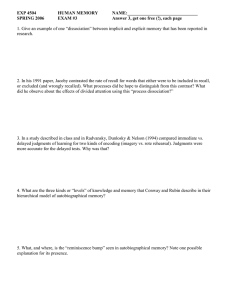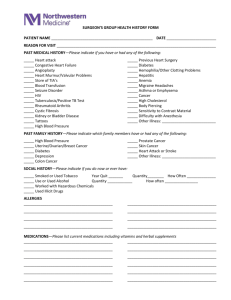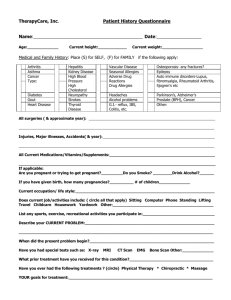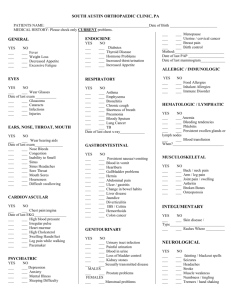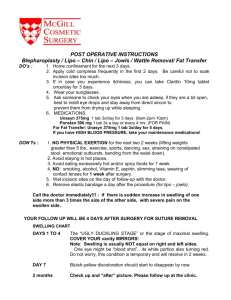Injury Evaluation Terminology
advertisement
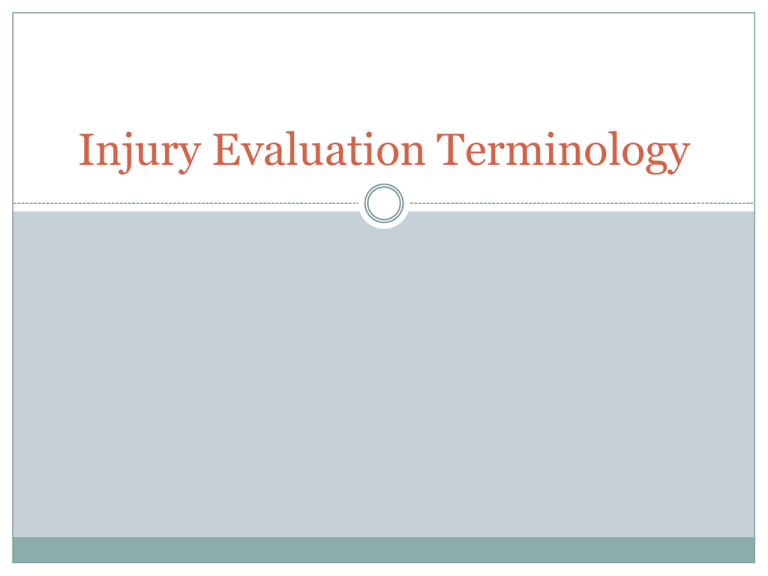
Injury Evaluation Terminology WOUNDS Abrasion Top layer of skin is removed “road rash” “turf burn” Long healing time Re-injury How skin heals Abrasion Incision Skin is cut with something sharp Usually a deep wound “clean edges” Usually needs to be closed Sutures Staples Steri-strips Incision Laceration Skin is “torn” Characterized by jagged edges Usually deep More difficult to repair than an incision Laceration Avulsion Tissue is completely or partially “torn” away Tissue is usually “hanging off” Puncture Something has gone partially or completely through the skin “do not” remove whatever has punctured the skin It may be controlling bleeding Puncture Amputation Part of the body has been partially or completely removed Body part can sometime be re-attached Keep “part” Cold Dry Amputation Aaron Rolston Self-Amputation OTC – OVER THE COUNTER MEDICATION Acetaminophen OTC – pain killer Tylenol Pain reliever Headaches, fever and minor aches and pains No anti-inflammatory effect Not good for controlling swelling Same as CVS brand Acetaminophen Ibuprofen OTC - Anti-inflammatory Advil, Motrin, Rufen and Nuprin NSAID Non Steroidal AntiInflammatory Decrease swelling, menstrual cramping, headaches, fevers and arthritis Naproxen OTC -Anti-inflammatory Became OTC in US - 1994 Aleve NSAID Slightly stronger than Ibuprofen Decrease swelling, menstrual cramping, headaches, fevers and arthritis Amnesia Retrograde Amnesia Post-Traumatic Amnesia Patient cannot Patient cannot remember things that happened before the injury event What are good questions to assess whether an athlete has retrograde amnesia? remember things that happened after the injury event What are good questions to assess whether an athlete has post-traumatic amnesia? Paraplegia Quadriplegia Impairment of motor Impairment of motor and sensory function of the lower extremities and sensory functions of all their limbs and torso Palpation To touch an anatomical structure with your hands Palpating the tibial tuberosity How can palpation help you figure out what the injury is? Conjunctivitis “pink eye” Acute inflammation of the conjunctivitis Outermost part of the eye and the inner eye lids Highly contagious Aerobic Exercise “with oxygen” Moderate intensity for a relatively long period of time Distance running, swimming, biking, etc. Haile Gebrselassie 2:03.59 Anaerobic Exercise High intensity, short duration Examples heavy weight-lifting all types of sprints jumping rope hill climbing interval training rapid burst of hard exercise Any exercise done for more than 2 minutes is Aerobic Goniometer Instrument used to measure joint range of motion In degrees Quantify ROM Measure progress of rehab Atrophy Muscle gets smaller in size Result of Immobilization Injury / disease Lack of use Hypertrophy Muscle gets bigger in size Result of rehabilitation / training Bruise Contusion Ecchymosis A “bruise” “black and blue” caused when blood Most common sign of a vessels are damaged or broken as the result of a blow to the skin contusion D.O.M.S. Delayed Onset Muscle Soreness Pain and stiffness in muscles Several hours or days after strenuous exercise Usually subsided as your body get accustomed to the exercise Edema “swelling” Blood (or other fluids absorbed by soft tissue) Abnormal accumulation of fluid beneath the skin Check for pitting Diplopia “double vision” Often associated with concussion “halo”effect Epistaxis “bloody nose” Atilla the hun Nerve form a network of pathways for conducting information throughout the body. Hallux Valgus The “big toe” Bunion Greenstick Fracture is a fracture in a young individuals soft bone in which the bone bends and partially breaks. bone cracks but doesn't break all the way through Hyphema Accumulation of blood in the anterior chamber of the eye Result of blunt force trauma to the eye Color Blindness Test Tinea “ringworm” Skin infection caused by a fungus Warm Moist Dark Ringworm (tinea) Ischemia Restriction of blood flow Usually due to something wrong with the blood vessel Usually results in tissue damage or death Can cause severe damage because of the potential for a build-up of metabolic wastes Vasoconstriction Vasodilation Narrowing of the blood Widening of the blood vessels Contraction of the muscular wall of the vessel Usually large arteries Results in a decrease in blood flow to a part of the body vessels Relaxation of the muscular wall of the vessels Usually in large arteries Results in increase in blood flow to a part of the body (lower blood pressure) Tetanus “lock jaw” Preventable disease Caused by skin wound that becomes infected with Clostridium Tetani Commonly found in soil Tetanus “shot” Children Adult – every 10 years Photophobia Symptom Over-sensitivity or hypersensitivity to light Symptom of concussion Experience of discomfort or pain to the eyes due to light exposure

